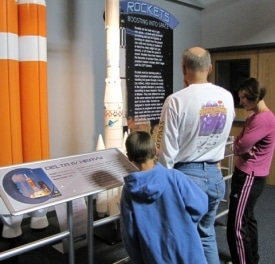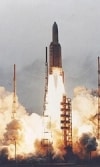Scale Model Rockets
Scale Model Rockets
Rockets boost objects from the ground into orbit, moving at speeds of at least five miles (eight km) per second, or 25 times the speed of sound.
Event Access:

 Rockets are the best way to get into space - at least until we invent something else just as capable of boosting an object from the ground into orbit and moving at speeds of at least five miles (eight km) per second, or 25 times the speed of sound. Rockets trace their history to the fireworks of ancient China, but practical modern rocketry didn't begin until the 20th century.
Rockets are the best way to get into space - at least until we invent something else just as capable of boosting an object from the ground into orbit and moving at speeds of at least five miles (eight km) per second, or 25 times the speed of sound. Rockets trace their history to the fireworks of ancient China, but practical modern rocketry didn't begin until the 20th century.
Rockets work by burning solid or liquid propellant and expelling the resulting hot gases through a nozzle (an action), which moves the rocket in the opposite direction (a reaction), according to Isaac Newton's Third Law of Motion. They look different for many of the same reasons that automobiles don't all look alike. Rockets are designed to handle various types of missions by engineers who approach their work with their own unique style and understanding of what they think will work best, depending on their available resources.
 Ariane 44LP
Ariane 44LP
The Ariane 4 family of rockets was operated by the European commercial launch firm Arianespace and launched from the Guiana Space Center in South America. It flew 116 times between 1988 and 2003, carrying a variety of communications, Earth observation and science research satellites. The 1/20th scale display model - a basic Ariane 4 equipped with a pair each of liquid and solid rocket boosters - was donated by Arianespace. The actual rocket stood 192.7 ft. (58.72 m) tall and had a diameter of 12.5 ft. (3.8 m).
 Ariane 5
Ariane 5
Arianespace's heavy-lift Ariane 5, operated from the Guiana Space Center, has launched satellites for every major U.S. operator and manufacturer including more than half the commercial satellites in geostationary orbit. Its missions include the Rosetta comet-chasing spacecraft, ATV cargo resupply to the International Space Station and the CHIRP and WAAS hosted payload for the FAA and U.S. Air Force. The 1/20 scale display model was donated by Arianespace; the actual rocket is 151-171 ft. (46-52 m) tall, 18 ft. (5.4 m) in diameter.
 Atlas V (500 Series)
Atlas V (500 Series)
The Atlas V family of rockets is operated by United Launch Alliance and first flew in 2002. Customers include the Air Force, National Reconnaissance Office and NASA. It is launched from Cape Canaveral Air Force Station, Fla., and Vandenberg Air Force Base, Calif. The 1/20th scale model version on display is a basic Atlas V equipped with four solid rocket boosters and an extended, larger-diameter nosecone. The Atlas V (500 Series) stands 215 ft. (65.5 m) tall and is 12.5 ft. (3.8 m) in diameter.
 Delta IV Heavy
Delta IV Heavy
Donated by operator United Launch Alliance (ULA), the 1/20th scale model of the Delta IV Heavy was built for the Space Foundation. Delta IV customers include the Air Force, National Reconnaissance Office and NASA/NOAA. Launched from Cape Canaveral Air Force Station, Fla., and Vandenberg Air Force Base, Calif., the Delta IV first flew in 2002. The largest and most powerful of the Delta IV family, the Delta IV Heavy stands 232 ft. (70.7 m) high and 16.4 ft. (5 m) in diameter and features a pair of "Common Booster Core" stages strapped to its side.
For more information on rockets, click here.
Space Foundation Discovery Center presents "It's Not Just Rocket Science!"
In this episode, our Executive Director Kevin Orangers spotlights the RL10 Aerojet Rocketdyne rocket engine! He also explores Newton's three Laws of Motion with a focus on how an engine works to provide power and thrust to things like motorcycles and rockets, respectively.
Discovery Center volunteer and Former NASA rocket engineer, Lou Ramon, speaks about his experience as an Apollo 11 rocket engineer and describes the difference between an RL10 rocket engine and how it works in comparison to a motorcycle engine!
The Space Foundation Discovery Center Presents a Science On a Sphere® Presentation of Rocketry 101.
Rockets are the vehicles we use to get to space. Rocket science, though, still follows basic physics like Newton’s Laws of Motion. This video connects Newton’s 3 Laws to rocket motion. It also includes a couple examples of rocket engines that have been used in the past to get very important payloads to space.
